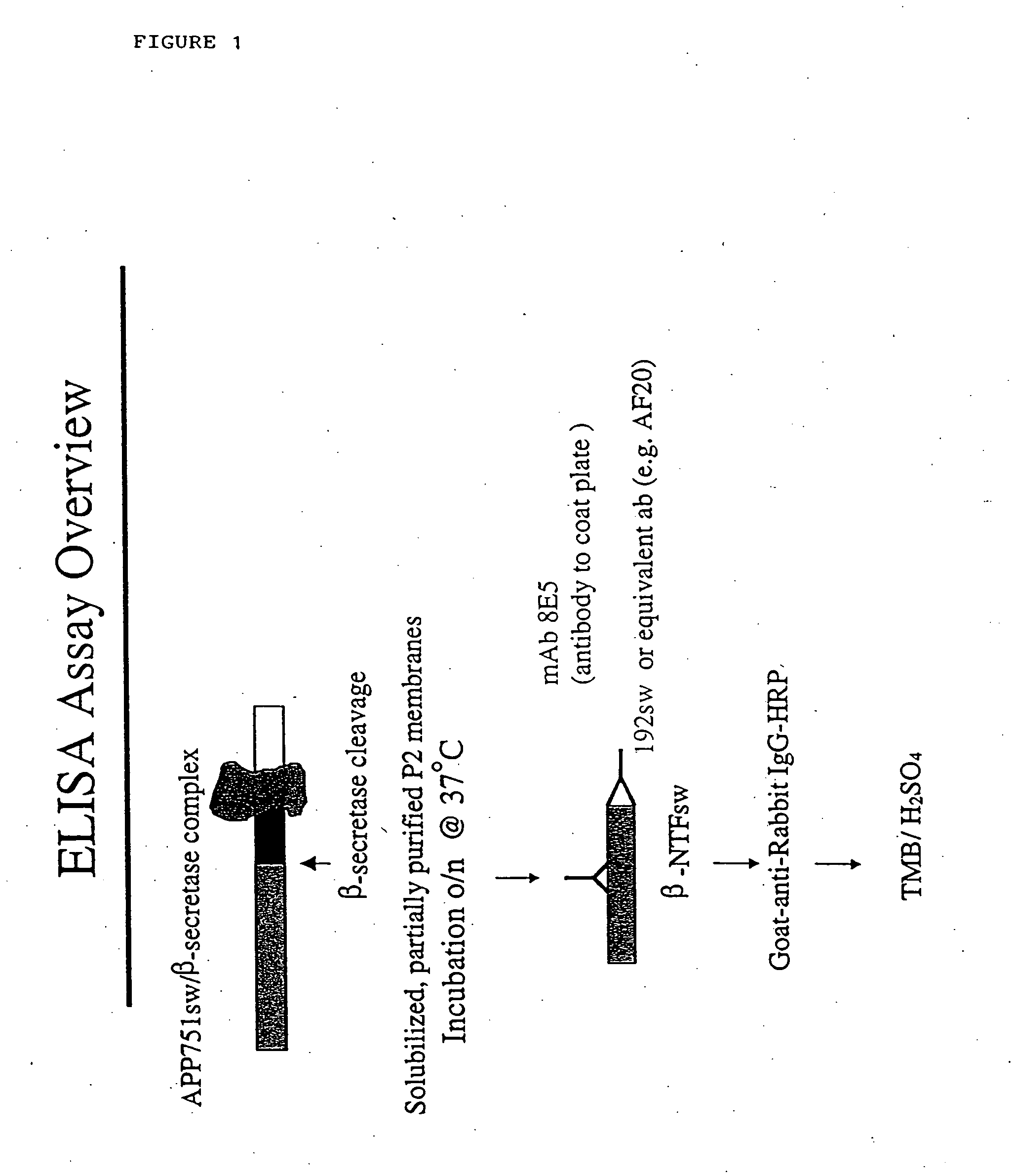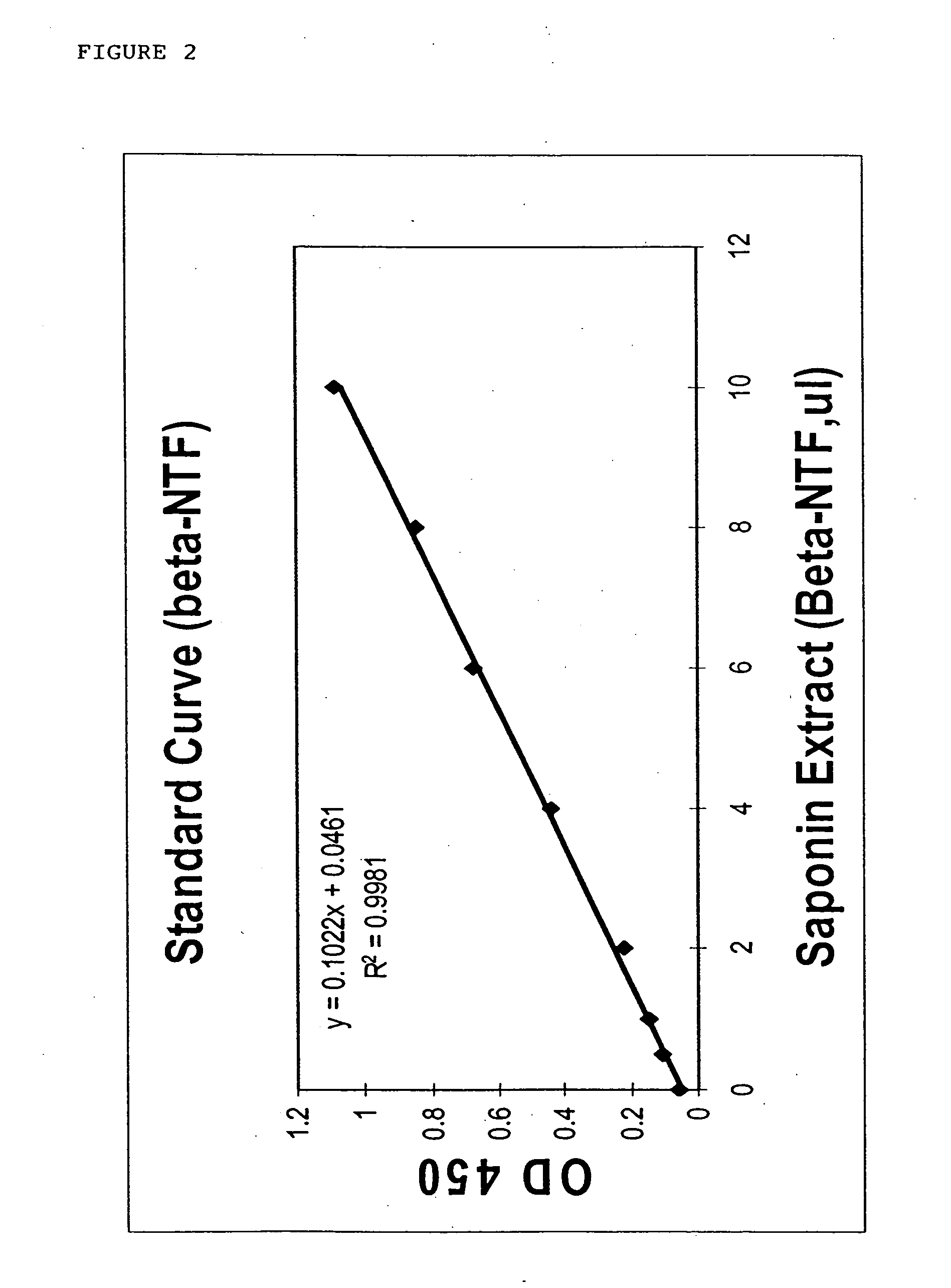Novel beta-secretase and modulation of beta-secretase activity
a beta-secretase and beta-secretase technology, applied in the direction of chemical treatment enzyme inactivation, peptides, drug compositions, etc., can solve the problems of inability to detect additional enzymes, and inability to adapt well to the effect of cognitive functions
- Summary
- Abstract
- Description
- Claims
- Application Information
AI Technical Summary
Problems solved by technology
Method used
Image
Examples
example 1
Membrane Preparation Protocol
[0105] Membrane preparations for APP / .beta.-secretase substrate mixtures were generated from human embryonic kidney 293 cells (HEK293) expressing the 751 form of APP carrying the "Swedish" AD mutation (293 / 751sw). For other purposes such as following or purifying .beta.-secretase activity, membrane extracts were made from nave HEK293 cells. This protocol can also be used for all other cell types, e.g. Chinese hamster ovary cells expressing an exogenous human APP gene (CHO-695APP). Cells were stored as cell pellets at -80.degree. C. until used for the preparation.
[0106] Approximately 70-100 gram of cells (wet weight) were routinely used to generate 50-100 mls of enzyme substrate complex / mixture from membrane extracts. The cells were thawed and were resuspended through different iterations in a total volume of 12-15.times.vol / gram wet weight of TE / 1.times. protease inhibitor cocktail (PIC) buffer [20 mM Tris-HCl / 5 mM EDTA pH 8.5 (TE) with 1.times.PIC (1.ti...
example 2
Detergent Wash of Membrane Preparation
[0107] Membrane preparations as prepared in Example 1 are treated with a mild detergent to reduce, preferably to undetectable levels, background APP proteolytic products. The membrane pellet was resuspended sequentially in a total of 12.times.vol / gram wet weight of TE / 1.times.PIC in the presence of a final concentration of 0.02% saponin (added from a 0.5% saponin stock solution made in distilled water). The pellet was homogenized on ice by 13-18 strokes in a Kontes glass tissue homogenizer with a tight pestle (0.013-0.14 mm clearance). Treatment with the mild detergent saponin permeabilizes the membranes and thus releases lumenal soluble proteins. In particular, this preferably reduces, to undetectable levels, any background APP proteolytic products, such as .beta.-NTF. Following homogenization of the membranes on ice, the suspension was centrifuged in a Ti45 rotor at 28,000 rpm (.about.65,000.times.g) for 30-40 minutes. The saponin extract cont...
example 3
Partial Purification of the APP / .beta.-Secretase Mixture
[0109] The detergent-treated membrane preparations of Example 2 are partially purified using a Q-HP Sepharose chromatography column (Pharmacia, Stamford, Conn.). The Q-HP column was equilibrated with 5-10 column volumes (CVs) of equilibration buffer [20 mM Tris / EDTA pH 8.5, 0.05% Triton X100--R] and the extract was loaded at 5 ml / minutes. The column was then washed with 5 CVs of equilibration buffer to remove non-specifically bound proteins. Proteins including APP and .beta.-secretase were eluted from the column with a linear gradient from 0-1M NaCl in equilibration buffer [TE, 0.05% Triton X100-R] over 5 CVs and .about.8 ml fractions were collected. 1.times.PIC was added to the collection tubes prior to the run.
[0110] Following elution, the column was washed well with 1M NaCl / TE buffer, and 0.5N NaOH with intermittent rinses in distilled water and was then re-equilibrated and stored at 4.degree. C. until future use. For long-t...
PUM
| Property | Measurement | Unit |
|---|---|---|
| molecular weight | aaaaa | aaaaa |
| molecular weight | aaaaa | aaaaa |
| molecular weight | aaaaa | aaaaa |
Abstract
Description
Claims
Application Information
 Login to view more
Login to view more - R&D Engineer
- R&D Manager
- IP Professional
- Industry Leading Data Capabilities
- Powerful AI technology
- Patent DNA Extraction
Browse by: Latest US Patents, China's latest patents, Technical Efficacy Thesaurus, Application Domain, Technology Topic.
© 2024 PatSnap. All rights reserved.Legal|Privacy policy|Modern Slavery Act Transparency Statement|Sitemap



